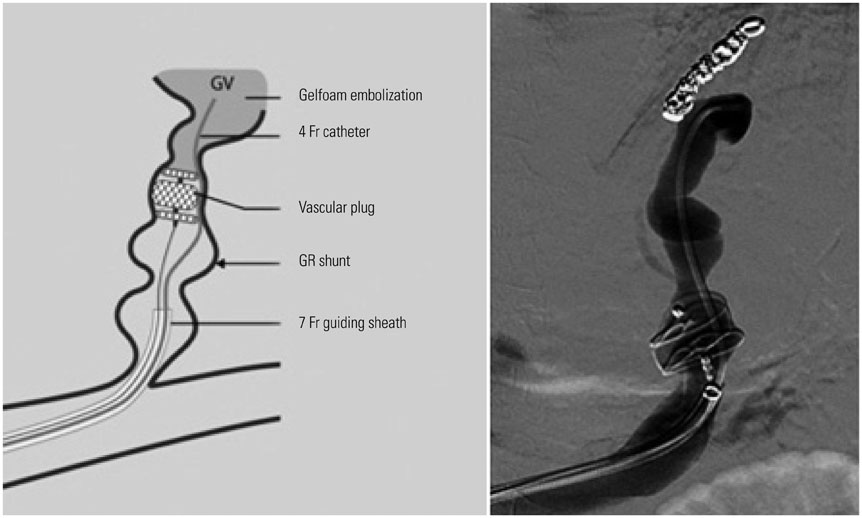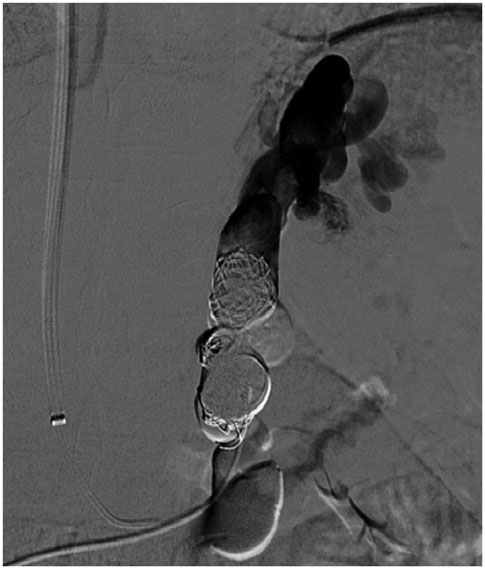Yonsei Med J.
2016 Jul;57(4):973-979. 10.3349/ymj.2016.57.4.973.
Vascular Plug Assisted Retrograde Transvenous Obliteration (PARTO) for Gastric Varix Bleeding Patients in the Emergent Clinical Setting
- Affiliations
-
- 1Department of Vascular and Interventional Radiology, NHIS Ilsan Hospital, Goyang, Korea. azide2@naver.com
- 2Department of Internal Medicine, NHIS Ilsan Hospital, Goyang, Korea.
- 3Department of Emergency Medicine, NHIS Ilsan Hospital, Goyang, Korea.
- KMID: 2374132
- DOI: http://doi.org/10.3349/ymj.2016.57.4.973
Abstract
- PURPOSE
To evaluate the technical feasibility and safety of vascular plug assisted retrograde transvenous obliteration (PARTO) for bleeding gastric varix performed in the emergent clinical setting and describe the mid-term clinical results.
MATERIALS AND METHODS
From April 2012 to January 2015, emergent PARTO was tried in total 9 patients presented with active gastric varix bleeding. After initial insufficient or failure of endoscopic approach, they underwent PARTO in the emergent clinical setting. Gelatin sponge embolization of both gastrorenal (GR) shunt and gastric varix was performed after retrograde transvenous placement of a vascular plug in GR shunt. Coil assisted RTO (CARTO) was performed in one patient who had challenging GR shunt anatomy for vascular plug placement. Additional embolic materials, such as microcoils and NBCA glue-lipiodol mixture, were required in three patients to enhance complete occlusion of GR shunt or obliteration of competitive collateral vessels. Clinical success was defined as no variceal rebleeding and disappearance of gastric varix.
RESULTS
All technical and clinical success-i.e., complete GR shunt occlusion and offending gastric varix embolization with immediate bleeding control-was achieved in all 9 patients. There was no procedure-related complication. All cases showed successful clinical outcome during mean follow up of 17 months (12-32 months), evidenced by imaging studies, endoscopy and clinical data. In 4 patients, mild worsening of esophageal varices or transient ascites was noted as portal hypertensive related change.
CONCLUSION
Emergent PARTO is technically feasible and safe, with acceptable mid-term clinical results, in treating active gastric varix bleeding.
Keyword
MeSH Terms
Figure
Cited by 1 articles
-
Plug-Assisted Retrograde Transvenous Obliteration for the Treatment of Gastric Varices: The Role of Intra-Procedural Cone-Beam Computed Tomography
Dong Il Gwon, Gi-Young Ko, Young Baek Kwon, Hyun-Ki Yoon, Kyu-Bo Sung
Korean J Radiol. 2018;19(2):223-229. doi: 10.3348/kjr.2018.19.2.223.
Reference
-
1. de Franchis R, Primignani M. Natural history of portal hypertension in patients with cirrhosis. Clin Liver Dis. 2001; 5:645–663.
Article2. Chang CJ, Hou MC, Liao WC, Chen PH, Lin HC, Lee FY, et al. Management of acute gastric varices bleeding. J Chin Med Assoc. 2013; 76:539–546.
Article3. de Franchis R. Acute variceal haemorrhage: practice guidelines and real-life management. Dig Liver Dis. 2014; 46:398–399.
Article4. Ryan BM, Stockbrugger RW, Ryan JM. A pathophysiologic, gastroenterologic, and radiologic approach to the management of gastric varices. Gastroenterology. 2004; 126:1175–1189.
Article5. Kiyosue H, Ibukuro K, Maruno M, Tanoue S, Hongo N, Mori H. Multidetector CT anatomy of drainage routes of gastric varices: a pictorial review. Radiographics. 2013; 33:87–100.
Article6. Kirby JM, Cho KJ, Midia M. Image-guided intervention in management of complications of portal hypertension: more than TIPS for success. Radiographics. 2013; 33:1473–1496.
Article7. Hirota S, Matsumoto S, Tomita M, Sako M, Kono M. Retrograde transvenous obliteration of gastric varices. Radiology. 1999; 211:349–356.
Article8. Park JK, Saab S, Kee ST, Busuttil RW, Kim HJ, Durazo F, et al. Balloon-occluded retrograde transvenous obliteration (BRTO) for treatment of gastric varices: review and meta-analysis. Dig Dis Sci. 2015; 60:1543–1553.
Article9. Kiyosue H, Mori H, Matsumoto S, Yamada Y, Hori Y, Okino Y. Transcatheter obliteration of gastric varices: part 2. Strategy and techniques based on hemodynamic features. Radiographics. 2003; 23:921–937.10. Matsumoto A, Hamamoto N, Nomura T, Hongou Y, Arisaka Y, Morikawa H, et al. Balloon-occluded retrograde transvenous obliteration of high risk gastric fundal varices. Am J Gastroenterol. 1999; 94:643–649.
Article11. Choi SY, Won JY, Kim KA, Lee do Y, Lee KH. Foam sclerotherapy using polidocanol for balloon-occluded retrograde transvenous obliteration (BRTO). Eur Radiol. 2011; 21:122–129.
Article12. Saad WE. Balloon-occluded retrograde transvenous obliteration of gastric varices: concept, basic techniques, and outcomes. Semin Intervent Radiol. 2012; 29:118–128.
Article13. Garcia-Pagán JC, Barrufet M, Cardenas A, Escorsell A. Management of gastric varices. Clin Gastroenterol Hepatol. 2014; 12:919–928.e1.
Article14. Gwon DI, Ko GY, Yoon HK, Sung KB, Kim JH, Shin JH, et al. Gastric varices and hepatic encephalopathy: treatment with vascular plug and gelatin sponge-assisted retrograde transvenous obliteration--a primary report. Radiology. 2013; 268:281–287.
Article15. Lee EW, Saab S, Gomes AS, Busuttil R, McWilliams J, Durazo F, et al. Coil-assisted retrograde transvenous obliteration (CARTO) for the treatment of portal hypertensive variceal bleeding: preliminary results. Clin Transl Gastroenterol. 2014; 5:e61.
Article16. Saad WE, Nicholson DB. Optimizing logistics for balloon-occluded retrograde transvenous obliteration (BRTO) of gastric varices by doing away with the indwelling balloon: concept and techniques. Tech Vasc Interv Radiol. 2013; 16:152–157.
Article17. Gwon DI, Kim YH, Ko GY, Kim JW, Ko HK, Kim JH, et al. Vascular plug-assisted retrograde transvenous obliteration for the treatment of gastric varices and hepatic encephalopathy: a prospective multicenter study. J Vasc Interv Radiol. 2015; 26:1589–1595.
Article18. Tajiri T, Yoshida H, Obara K, Onji M, Kage M, Kitano S, et al. General rules for recording endoscopic findings of esophagogastric varices (2nd edition). Dig Endosc. 2010; 22:1–9.
Article19. Sarin SK. Long-term follow-up of gastric variceal sclerotherapy: an eleven-year experience. Gastrointest Endosc. 1997; 46:8–14.
Article20. Sarin SK, Kumar A, Angus PW, Baijal SS, Baik SK, Bayraktar Y, et al. Diagnosis and management of acute variceal bleeding: Asian Pacific Association for Study of the Liver recommendations. Hepatol Int. 2011; 5:607–624.
Article21. Sacks D, McClenny TE, Cardella JF, Lewis CA. Society of Interventional Radiology clinical practice guidelines. J Vasc Interv Radiol. 2003; 14(9 Pt 2):S199–S202.
Article22. Saad WE, Khaja MS, Hirota S. Balloon-occluded retrograde transvenous obliteration of gastric varices: conception, evolution, and history. Tech Vasc Interv Radiol. 2012; 15:160–164.
Article23. Sonomura T, Ono W, Sato M, Sahara S, Nakata K, Sanda H, et al. Emergency balloon-occluded retrograde transvenous obliteration of ruptured gastric varices. World J Gastroenterol. 2013; 19:5125–5130.
Article24. Koito K, Namieno T, Nagakawa T, Morita K. Balloon-occluded retrograde transvenous obliteration for gastric varices with gastrorenal or gastrocaval collaterals. AJR Am J Roentgenol. 1996; 167:1317–1320.
Article25. Kanagawa H, Mima S, Kouyama H, Gotoh K, Uchida T, Okuda K. Treatment of gastric fundal varices by balloon-occluded retrograde transvenous obliteration. J Gastroenterol Hepatol. 1996; 11:51–58.
Article26. Katoh K, Sone M, Hirose A, Inoue Y, Fujino Y, Onodera M. Balloon-occluded retrograde transvenous obliteration for gastric varices: the relationship between the clinical outcome and gastrorenal shunt occlusion. BMC Med Imaging. 2010; 10:2.
Article27. Kiyosue H, Matsumoto S, Onishi R, Okahara M, Hori Y, Yamada Y, et al. [Balloon-occluded retrograde transvenous obliteration (B-RTO) for gastric varices: therapeutic results and problems]. Nihon Igaku Hoshasen Gakkai Zasshi. 1999; 59:12–19.28. Ninoi T, Nishida N, Kaminou T, Sakai Y, Kitayama T, Hamuro M, et al. Balloon-occluded retrograde transvenous obliteration of gastric varices with gastrorenal shunt: long-term follow-up in 78 patients. AJR Am J Roentgenol. 2005; 184:1340–1346.
Article29. Watanabe K, Kimura K, Matsutani S, Ohto M, Okuda K. Portal hemodynamics in patients with gastric varices. A study in 230 patients with esophageal and/or gastric varices using portal vein catheterization. Gastroenterology. 1988; 95:434–440.
Article30. Choi YS, Lee JH, Sinn DH, Song YB, Gwak GY, Choi MS, et al. Effect of balloon-occluded retrograde transvenous obliteration on the natural history of coexisting esophageal varices. J Clin Gastroenterol. 2008; 42:974–979.
Article31. Saad WE, Simon PO Jr, Rose SC. Balloon-occluded retrograde transvenous obliteration of gastric varices. Cardiovasc Intervent Radiol. 2014; 37:299–315.
Article
- Full Text Links
- Actions
-
Cited
- CITED
-
- Close
- Share
- Similar articles
-
- Plug-Assisted Retrograde Transvenous Obliteration for the Treatment of Gastric Varix with Both Gastrorenal and Gastrocaval Shunts: A Case Report
- Plug-Assisted Retrograde Transvenous Obliteration for the Treatment of Gastric Varices: The Role of Intra-Procedural Cone-Beam Computed Tomography
- Plug-Assisted Retrograde Transvenous Obliteration for the Treatment of Duodenal Variceal Bleeding - A Case Report and Literature Review
- Successful Treatment of Duodenal Variceal Bleeding with Coil-Assisted Retrograde Transvenous Obliteration: A Case Report
- Plug-Assisted Retrograde Transvenous Obliteration for the Treatment of Gastric Variceal Hemorrhage




